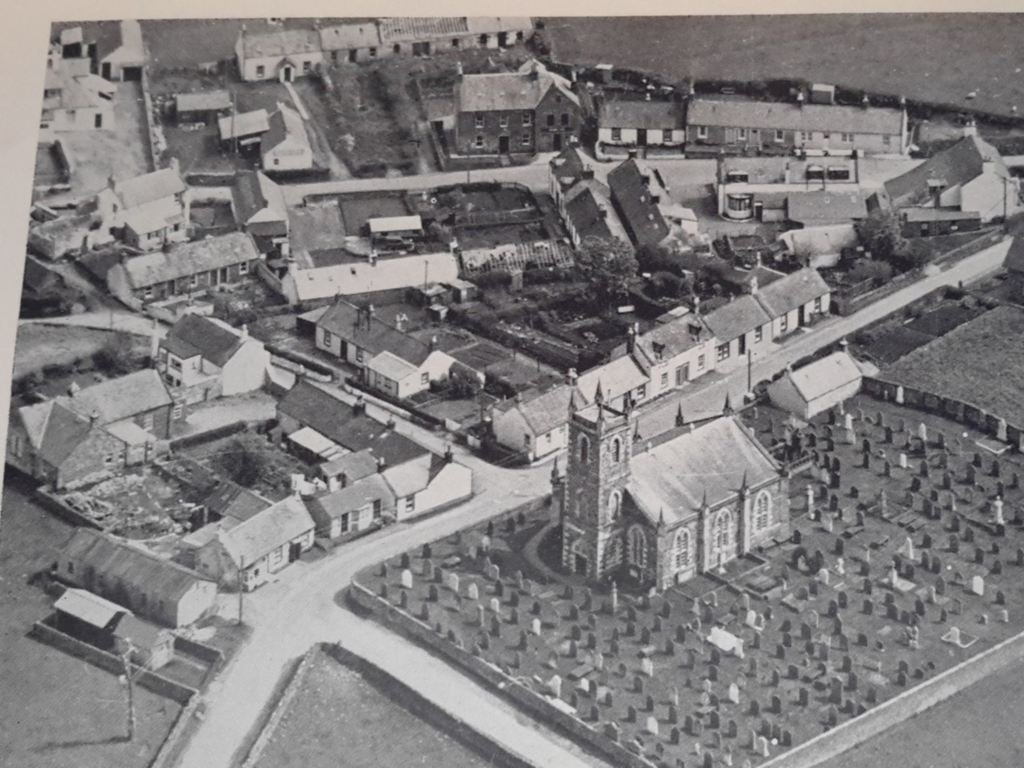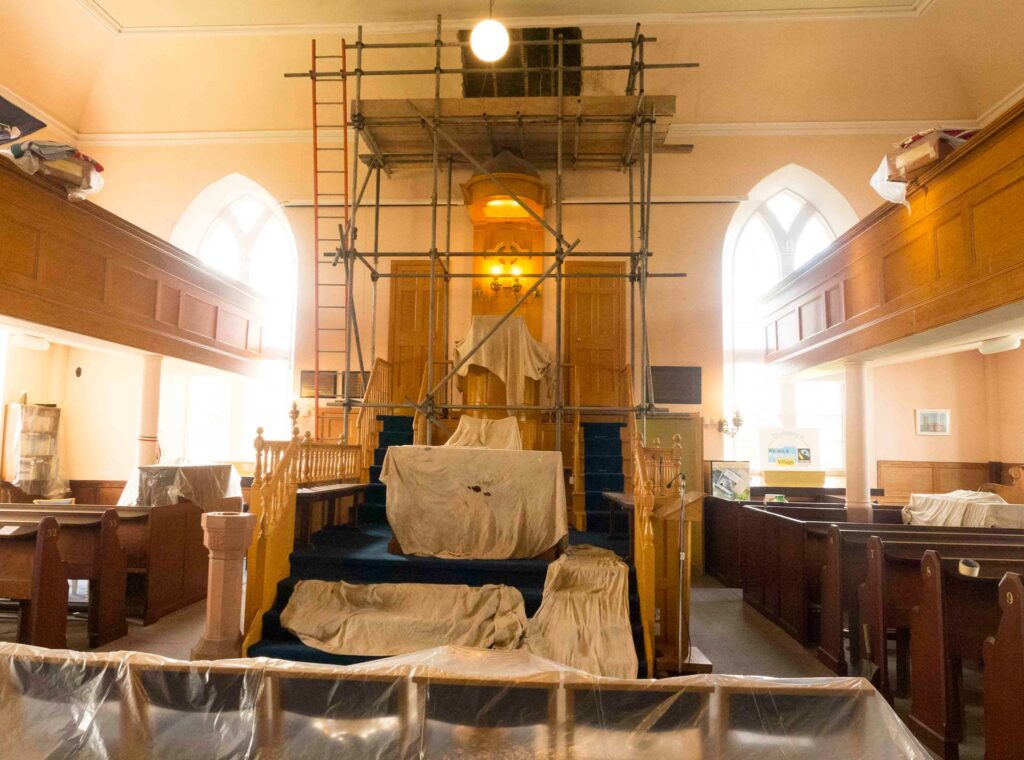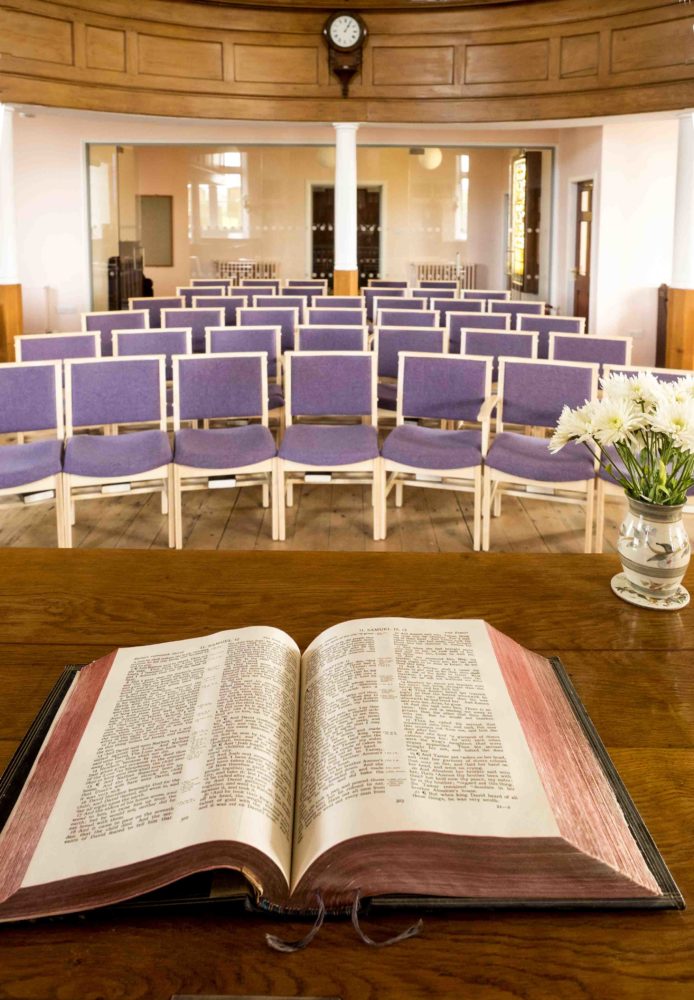The Church
There has been a church in the parish back as far as the 12th century. The current Dunscore Church was built in 1823 and has been used for worship ever since. It is a “Heritor’s Gothic” grade A listed church.



Old Dunscore Kirk was originally close to Old Dunscore Kirkyard, near Gateside of Isle.
In 1649, James Grierson of Dalgonar and James Kirko of Sundaywell presented a petition to the Scots Parliament, seeking to move it to its present site. They stated that the old Kirk was so ruinous that ‘they daere not for hazard of their life repaire thearto for Godis worship’.
So James Grierson granted a feu, and the Kirk was built on its present site, in the village which was then called Cottack.
The copper baptismal font was brought from the old Kirk, and secreted in one of the walls. The manse at Mansegate was built in 1659. You can view a 1654 map of the area here.
In 1823, the then Kirk, which had by then also become ruinous, was demolished and the present Kirk was built, with room for 850 worshippers, despite the then James Grierson of Dalgonar’s stipulation that it should have room for a thousand. The old baptismal font was again built into the wall. The architect was James Thomson of Dumfries, and the cost was £1,072. At about this time, the village is no longer described on the maps as Cottack, but Dunscore (which was always the name of the Parish). In 1923, Mrs Hamilton Walker of Dalgonar, at the suggestion of the Session, had the baptismal font taken out of the wall, and set up in its present stand.


The Revd. Robt. Archibald was the first minister in the new Kirk; he, like 300 other ministers in Dumfries and Galloway , when the Rescissory Act was passed in 1663, left his new manse and his Kirk, took to the hills, and preached at conventicles. Both James Grierson and James Kirko supported him strongly; Grierson was fined, and then imprisoned at Ayr; Kirko in the Tolbooth in Edinburgh. Kirko, after his release, organised and attended, as did Grierson, the great conventicle on Skeoch in 1678.
Apart from the font, the only other connection with the original Dunscore Kirk is the carved sandstone plaque on the outside east gable-end inscribed ‘How amiable are thy tabernacles, O Lord of Hosts to me’..


Around 1950 the exterior sandstone was painted white and in 1990, the rooms at the rear of the church were installed, reducing the seating capacity. In 1978, Moniaive and Glencairn, and Dunscore were combined into a single parish, but all three churches were retained, and are still in use today.


In 1994, the East Kirk at Merkland was finally abandoned as a place of worship. Those who sought to retain it, put up a gallant fight but, finally, its congregation moved to Dunscore.
The interior of the Church has a large panel on its east wall (erected in 1973) naming the priests and ministers who have served the parish over many centuries. Dunscore is in the heart of Covenanting country and its one-time minister, Rev. Archibald, was ousted from his charge during this period.

Several changes have been made to the church in more recent years.
Around 1990, the pews were removed from the central section to make the church into a more flexible space for meetings and small gatherings.
Projectors and screens were installed in 2010 so that the words of hymns could be displayed. The screens are also used for talks and meetings and allow photographs and other visual aids to be displayed during the service.
In 2011 the paint that had been applied to details around doors and windows at about 1950 was removed. The last time the church exterior had been repainted was in the 1970s and so it either needed repainting or for the paint to be removed and the latter course was decided.


A winter storm in 2013 caused significant damage through water ingress.
Several years of planning and fund-raising followed resulting in significant repairs to the roof, walls and windows and modifications to the church interior.
The chancel was lowered and shortened and the barriers removed, many of the pews were replaced with chairs, a servery was installed and an accessible toilet was created.
A glass screen replaced a wall at the rear of the church and the Heritage Centre was created.
The work was completed in 2017.

Timeline of Dunscore Parish Church
1170
Place of worship established by a Norman Lord. Land gifted to the Abbey of Holiwood (note spelling) by Cistercian Monks of Melrose. First mention of a church at Portrack in a monastic dispute.
1560
Reformation.
1567
John Welsh appointed first “vicar” of Dunscore parish.
1638
National Covenant signed.
1649
Church built at Dunscore village.
1651
Rev. Archibald became first minister.
1659
Dunscore manse built.
1662
Act passed restoring government by Bishops and Archbishops.
1663
Rev. Archibald left church and took to the hills to conduct conventicles.
1690
Revolution Statement. Presbyterianism once again restored.
1740
Dunscore manse built.
1814
Dunscore manse rebuilt.
1823
Dunscore Church rebuilt. Original baptismal font built into wall.
1824
Craig Church opened as a meeting house. (Reformed Presbyterian).
1870
Craig Church allowed to induct a regular minister.
1876
Craig Church joined with the Free Church.
1890
Craig Church manse built.
1897
Roof repaired and two ventilators fitted.
1899
East Church rebuilt.
1909
Pews replaced
1918
Dunscore East (Free) and Dunscore Renwick(UF) joined as Dunscore UF Church.
1923
Font removed from wall and installed inside Dunscore church.
1940
Dunscore united with East.
195?
Craig church closed.
1960
Chancel steps formed and centre pews replaced with pews from Moniaive church
1967
Clocks installed in tower in memory of Dr. Ramsay.
1971
Dunscore church became a Listed building (A).
1973
Past ministers board erected.
1978
Dunscore linked with Moniaive and Glencairn.
1984
New joint manse built at Wallaceton.
1990
New rear wall added to make room for kitchen, toilet and vestry.
1994
East Church closed.
2010
Projectors and screens installed.
2011
White paint removed from around doors and windows.
2016
Church repair and redevelopment started.
2017
Church reopens after completion of repairs and redevelopment.
2018
Heritage Centre opened.
2020
Church closed for worship during Covid-19 pandemic (services were held online).
